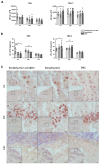Reduction of αSYN Pathology in a Mouse Model of PD Using a Brain-Penetrating Bispecific Antibody
- PMID: 35890306
- PMCID: PMC9318263
- DOI: 10.3390/pharmaceutics14071412
Reduction of αSYN Pathology in a Mouse Model of PD Using a Brain-Penetrating Bispecific Antibody
Abstract
Immunotherapy targeting aggregated alpha-synuclein (αSYN) is a promising approach for the treatment of Parkinson's disease. However, brain penetration of antibodies is hampered by their large size. Here, RmAbSynO2-scFv8D3, a modified bispecific antibody that targets aggregated αSYN and binds to the transferrin receptor for facilitated brain uptake, was investigated to treat αSYN pathology in transgenic mice. Ex vivo analyses of the blood and brain distribution of RmAbSynO2-scFv8D3 and the unmodified variant RmAbSynO2, as well as in vivo analyses with microdialysis and PET, confirmed fast and efficient brain uptake of the bispecific format. In addition, intravenous administration was shown to be superior to intraperitoneal injections in terms of brain uptake and distribution. Next, aged female αSYN transgenic mice (L61) were administered either RmAbSynO2-scFv8D3, RmAbSynO2, or PBS intravenously three times over five days. Levels of TBS-T soluble aggregated αSYN in the brain following treatment with RmAbSynO2-scFv8D3 were decreased in the cortex and midbrain compared to RmAbSynO2 or PBS controls. Taken together, our results indicate that facilitated brain uptake of αSYN antibodies can improve treatment of αSYN pathology.
Keywords: Parkinson’s disease (PD); alpha-synuclein (αSYN); bispecific antibody; blood-brain barrier (BBB); immunotherapy; monoclonal antibody; receptor-mediated transcytosis (RMT); transferrin receptor (TfR).
Conflict of interest statement
The authors declare no conflict of interest.
Figures





Similar articles
-
Long-term effects of immunotherapy with a brain penetrating Aβ antibody in a mouse model of Alzheimer's disease.Alzheimers Res Ther. 2023 May 2;15(1):90. doi: 10.1186/s13195-023-01236-3. Alzheimers Res Ther. 2023. PMID: 37131196 Free PMC article.
-
A brain-penetrant bispecific antibody lowers oligomeric alpha-synuclein and activates microglia in a mouse model of alpha-synuclein pathology.Neurotherapeutics. 2025 Mar;22(2):e00510. doi: 10.1016/j.neurot.2024.e00510. Epub 2024 Dec 14. Neurotherapeutics. 2025. PMID: 39676023 Free PMC article.
-
In vivo imaging of alpha-synuclein with antibody-based PET.Neuropharmacology. 2022 May 1;208:108985. doi: 10.1016/j.neuropharm.2022.108985. Epub 2022 Feb 8. Neuropharmacology. 2022. PMID: 35149134
-
α-Synuclein Radiotracer Development and In Vivo Imaging: Recent Advancements and New Perspectives.Mov Disord. 2022 May;37(5):936-948. doi: 10.1002/mds.28984. Epub 2022 Mar 15. Mov Disord. 2022. PMID: 35289424 Free PMC article. Review.
-
Blood-brain barrier drug delivery of IgG fusion proteins with a transferrin receptor monoclonal antibody.Expert Opin Drug Deliv. 2015 Feb;12(2):207-22. doi: 10.1517/17425247.2014.952627. Epub 2014 Aug 20. Expert Opin Drug Deliv. 2015. PMID: 25138991 Review.
Cited by
-
α-Synuclein pathology from the body to the brain: so many seeds so close to the central soil.Neural Regen Res. 2024 Jul 1;19(7):1463-1472. doi: 10.4103/1673-5374.387967. Epub 2023 Nov 8. Neural Regen Res. 2024. PMID: 38051888 Free PMC article.
-
Long-term effects of immunotherapy with a brain penetrating Aβ antibody in a mouse model of Alzheimer's disease.Alzheimers Res Ther. 2023 May 2;15(1):90. doi: 10.1186/s13195-023-01236-3. Alzheimers Res Ther. 2023. PMID: 37131196 Free PMC article.
-
AAV-mediated expression of a new conformational anti-aggregated α-synuclein antibody prolongs survival in a genetic model of α-synucleinopathies.NPJ Parkinsons Dis. 2023 Jun 15;9(1):91. doi: 10.1038/s41531-023-00542-9. NPJ Parkinsons Dis. 2023. PMID: 37322068 Free PMC article.
-
Bispecific antibodies revolutionizing breast cancer treatment: a comprehensive overview.Front Immunol. 2023 Dec 4;14:1266450. doi: 10.3389/fimmu.2023.1266450. eCollection 2023. Front Immunol. 2023. PMID: 38111570 Free PMC article. Review.
-
Receptor-mediated drug delivery of bispecific therapeutic antibodies through the blood-brain barrier.Front Drug Deliv. 2023;3:1227816. doi: 10.3389/fddev.2023.1227816. Epub 2023 Jul 10. Front Drug Deliv. 2023. PMID: 37583474 Free PMC article.
References
Grants and funding
- 2017-02413/Swedish Research Council
- 2018-02715/Swedish Research Council
- 2021-03524/Swedish Research Council
- 2021-01083/Swedish Research Council
- 2016-04050/Swedish Innovation Agency
- 2019-00106/Swedish Innovation Agency
- n/a/Hjärnfonden
- n/a/Torsten Söderbergs Stiftelse
- n/a/Åke Wibergs Stiftelse
- n/a/Petrus och Augusta Hedlunds Stiftelse
- n/a/Åhlén-Stiftelsen
- n/a/Parkinsonfonden
- n/a/Magnus Bergvalls Stiftelse
- n/a/Stiftelsen för Gamla Tjänarinnor
- n/a/Stohnes stiftelse
- n/a/Neurofonden
- n/a/Demensfonden
- n/a/Syskonen Inger och Sixten Norheds stiftelse
- n/a/Konung Gustaf V:s och Drottning Victorias frimurarestiftelse
LinkOut - more resources
Full Text Sources
Medical

